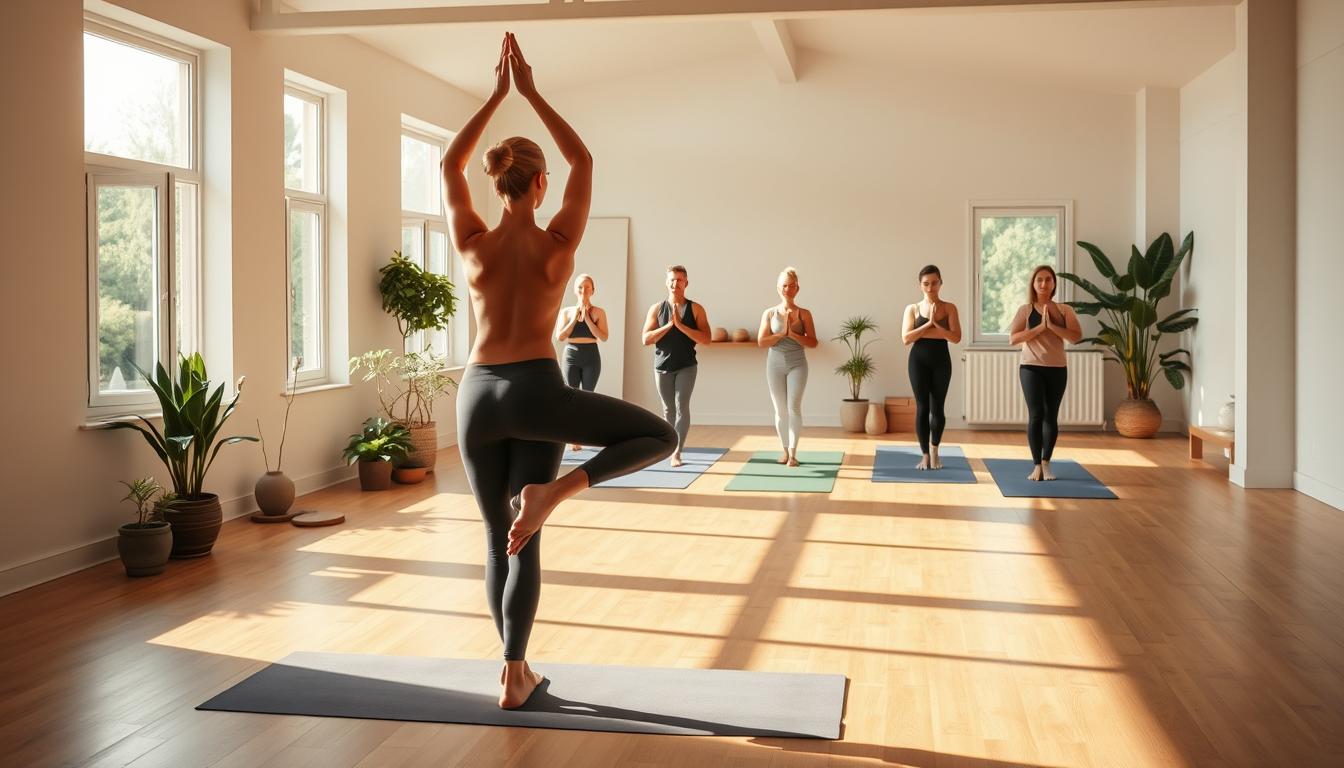Embarking on a journey to discover inner peace and balance, many of us find solace in the ancient practice of yoga. As a beginner, stepping into the world of yoga can be both exciting and intimidating.
With its roots in mindfulness and physical postures, yoga offers a holistic approach to well-being, combining breathwork, movement, and meditation to foster a deeper connection between body, mind, and spirit.
As you start your yoga journey, you’ll discover how this practice can transform your life, enhancing flexibility, reducing stress, and promoting overall health.
Key Takeaways
- Understand the basics of yoga and its benefits for beginners
- Learn how to incorporate yoga into your daily routine
- Discover the different styles of yoga and their unique advantages
- Explore the connection between yoga, mindfulness, and overall well-being
- Find tips for creating a safe and effective home yoga practice
Understanding the Ancient Practice of Yoga
With a history spanning millennia, yoga has transformed from a spiritual practice to a holistic approach to health and wellness. Originating in ancient India, yoga combines physical postures, breathing techniques, and meditation to achieve a balanced state of being.
What Is Yoga and Its Origins
Yoga’s roots are deeply embedded in Hindu philosophy, aiming to unite the body, mind, and spirit. The practice has evolved over time, influenced by various cultures and traditions.
Different Types of Yoga for Beginners
For those new to yoga, several styles are particularly accessible: Hatha, Vinyasa, and Restorative yoga. Each style offers unique benefits, from physical postures to relaxation techniques.
| Yoga Style | Focus | Benefits |
|---|---|---|
| Hatha Yoga | Physical postures and breathing | Improves flexibility and balance |
| Vinyasa Yoga | Flowing movements and breath synchronization | Enhances cardiovascular health and coordination |
| Restorative Yoga | Relaxation and rejuvenation | Reduces stress and promotes healing |
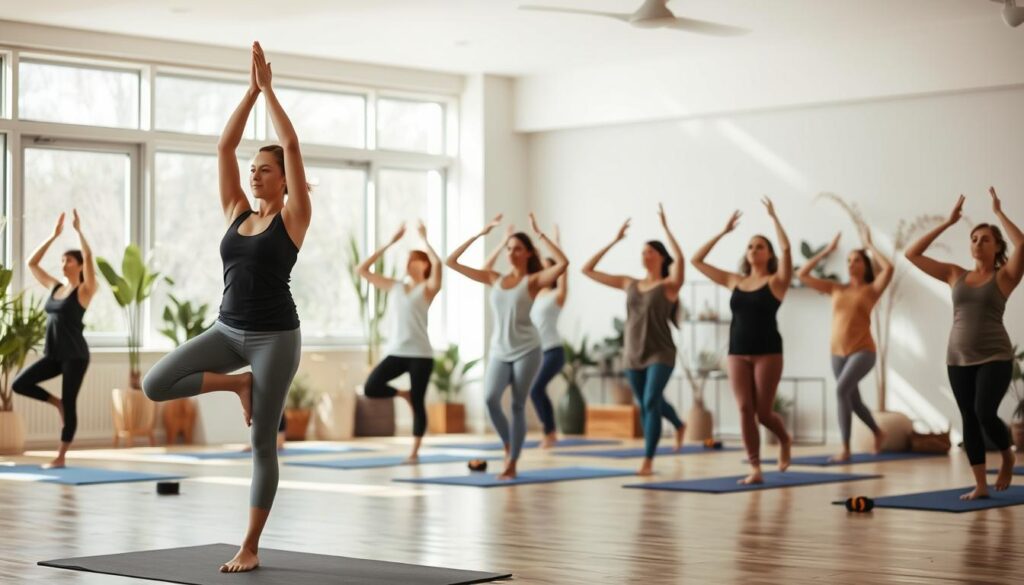
The Transformative Benefits of Yoga
Embracing yoga can lead to significant improvements in physical health, mental clarity, and emotional balance. As a holistic practice, yoga encompasses various techniques that work together to promote overall well-being.
Physical Health Benefits
Yoga improves flexibility, strength, and balance through various physical postures (asanas). Regular practice can also enhance cardiovascular health and reduce chronic pain.
- Increased flexibility and range of motion
- Improved muscle tone and strength
- Better balance and coordination
| Physical Benefit | Description |
|---|---|
| Flexibility | Increased range of motion through regular stretching |
| Strength | Improved muscle tone through holding postures |
| Balance | Enhanced coordination and stability |
Mental and Emotional Wellness
Yoga practice is known to reduce stress and anxiety by promoting relaxation and calming the mind. Techniques such as meditation and deep breathing are integral to achieving mental clarity and emotional stability.
Spiritual Growth and Self-Discovery
Yoga encourages a deeper connection with oneself, fostering spiritual growth and self-awareness. Through regular practice, individuals can cultivate a greater sense of inner peace and purpose.
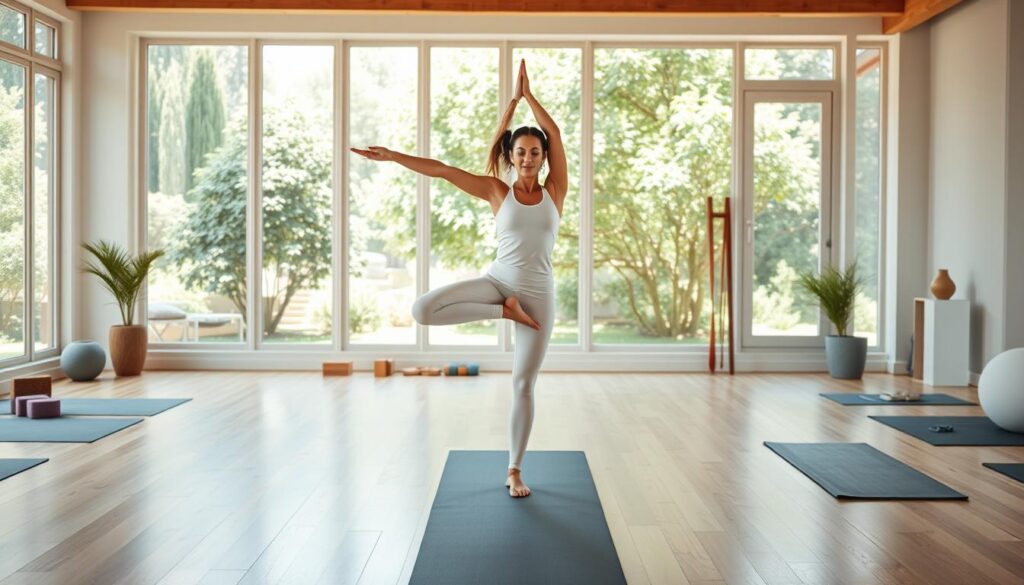
Essential Gear and Preparation for Your Yoga Journey
Embarking on a yoga journey requires more than just enthusiasm; it demands the right gear and a conducive environment. To start, you’ll need to select the appropriate equipment to support your practice.
Choosing the Right Yoga Mat and Props
A good yoga mat provides grip, comfort, and support. Consider a mat that suits your practice style, whether it’s hot yoga or restorative yoga. Props like blocks, straps, and blankets can also enhance your practice by providing additional support and helping you achieve proper alignment.
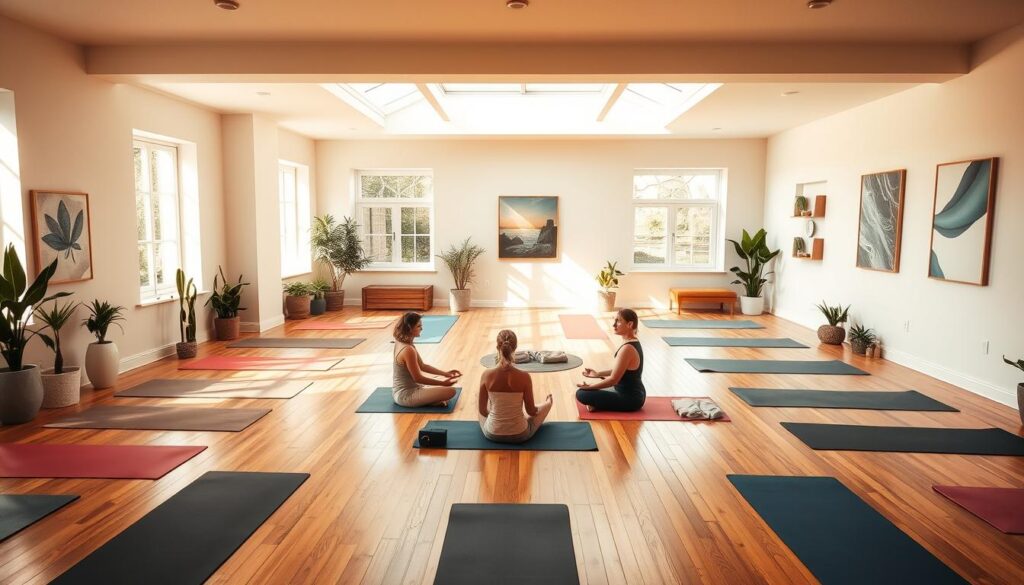
Creating a Peaceful Practice Space
Your practice space should be quiet, clean, and free from distractions. Whether you practice at home or in a yoga studio, creating a serene atmosphere is crucial. Consider lighting, temperature, and decor to create a calming ambiance.
What to Wear for Maximum Comfort
Wear comfortable, breathable clothing that allows for a full range of motion. The right attire can enhance your practice by keeping you cool and comfortable, allowing you to focus on your poses and breathing.
Fundamental Yoga Poses Every Beginner Should Master
To unlock the full potential of yoga, it’s essential to start with foundational poses that promote strength, flexibility, and relaxation. These poses are the cornerstone of a yoga practice, offering numerous benefits for the body, mind, and spirit.
Standing Poses for Strength and Balance
Standing poses are foundational in yoga, helping to establish balance, strength, and focus. They prepare the body for more complex poses and are essential for beginners.
Mountain Pose (Tadasana)
Mountain Pose is the foundation of all standing poses. It promotes good posture, balance, and grounding. To practice Tadasana, stand with your feet hip-width apart, arms by your sides, and engage your core.
Warrior Poses (Virabhadrasana)
Warrior Poses are excellent for building strength and stamina. They come in three variations: Warrior I, II, and III, each with unique benefits and challenges.
Tree Pose (Vrikshasana)
Tree Pose improves balance and focus. Stand on one leg, with the other foot resting on the inner thigh. Engage your core, and keep your arms by your sides or in prayer position.
Seated Poses for Flexibility
Seated poses are designed to increase flexibility, particularly in the hips, hamstrings, and back. They are essential for maintaining a healthy range of motion.
Easy Pose (Sukhasana)
Easy Pose is a simple seated pose that promotes flexibility and relaxation. Sit with your legs crossed, keeping your back straight.
Seated Forward Bend (Paschimottanasana)
Seated Forward Bend stretches the hamstrings, calves, and back. Sit with your legs extended, then lean forward, reaching for your toes.
Butterfly Pose (Baddha Konasana)
Butterfly Pose is excellent for hip flexibility. Sit with your legs bent, feet together, and let your knees fall apart.
Reclining Poses for Relaxation
Reclining poses are designed to promote relaxation and reduce stress. They are perfect for calming the mind and body.
Corpse Pose (Savasana)
Corpse Pose is a resting pose that rejuvenates the body and calms the mind. Lie on your back, arms and legs relaxed, and focus on your breath.
Legs-Up-The-Wall Pose (Viparita Karani)
Legs-Up-The-Wall Pose is a restorative pose that reduces swelling in the legs and promotes relaxation. Lie on your back with your legs up against a wall.
| Pose | Benefits | Level |
|---|---|---|
| Mountain Pose (Tadasana) | Improves posture, balance | Beginner |
| Warrior Poses (Virabhadrasana) | Builds strength, stamina | Beginner/Intermediate |
| Tree Pose (Vrikshasana) | Improves balance, focus | Beginner |
| Easy Pose (Sukhasana) | Promotes flexibility, relaxation | Beginner |
| Seated Forward Bend (Paschimottanasana) | Stretches hamstrings, calves, back | Beginner/Intermediate |
| Butterfly Pose (Baddha Konasana) | Improves hip flexibility | Beginner |
| Corpse Pose (Savasana) | Promotes relaxation, reduces stress | All levels |
| Legs-Up-The-Wall Pose (Viparita Karani) | Reduces swelling, promotes relaxation | All levels |
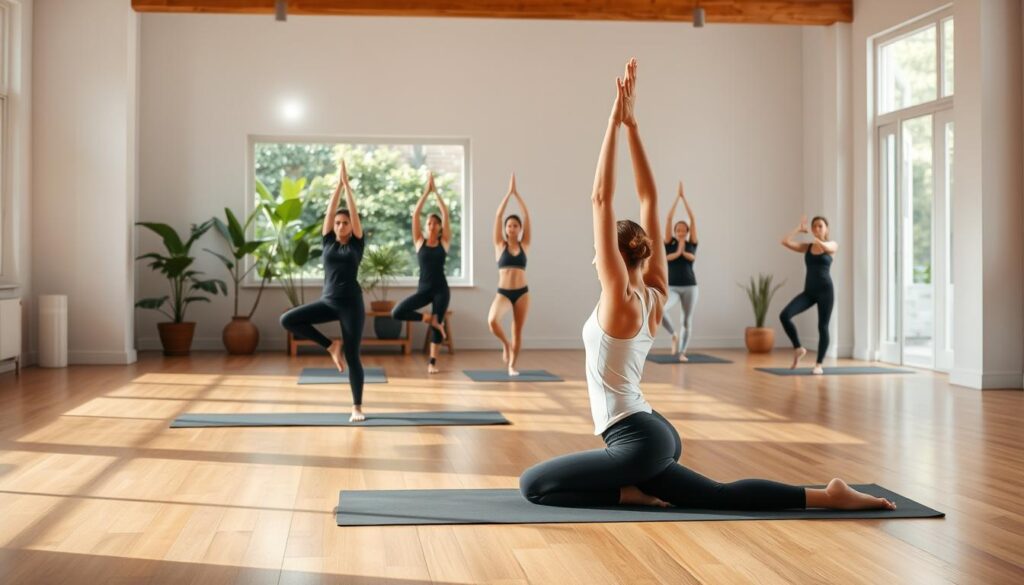
Building Your First Yoga Practice Routine
For those new to yoga, crafting a practice routine is an essential step towards inner zen. As you begin, it’s crucial to understand that a well-structured routine not only enhances your physical flexibility but also contributes to mental clarity and emotional balance.
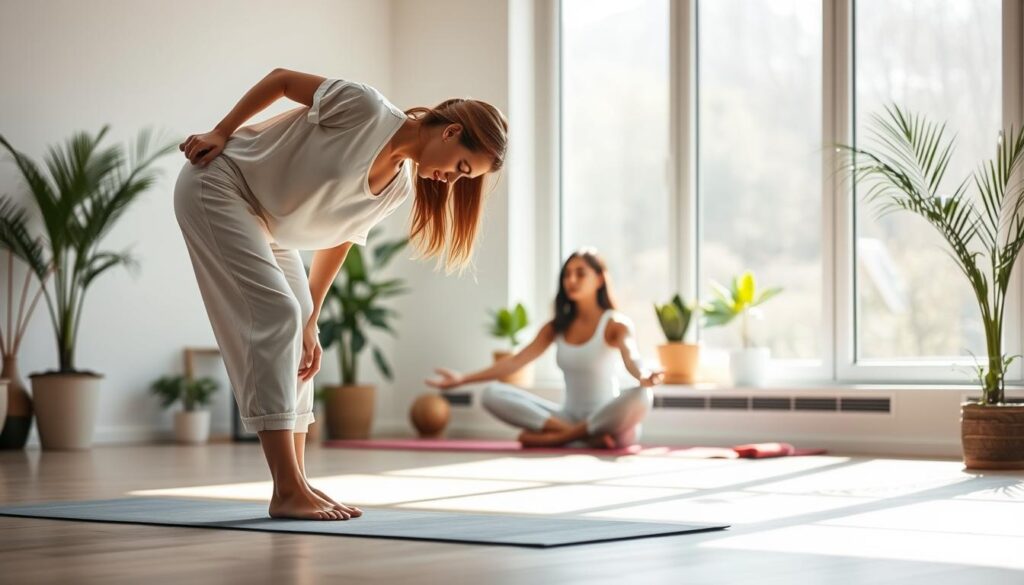
10-Minute Morning Energizer Sequence
Starting your day with a yoga routine can be incredibly invigorating. A 10-minute morning sequence can include poses like Mountain Pose (Tadasana), Downward-Facing Dog (Adho Mukha Svanasana), and Child’s Pose (Balasana). This sequence helps in awakening your body and preparing you for the day ahead.
20-Minute Evening Relaxation Flow
An evening yoga routine is perfect for unwinding after a long day. A 20-minute relaxation flow can include gentle stretches and restorative poses like Legs Up The Wall Pose (Viparita Karani) and Reclined Pigeon Pose (Supta Eka Pada Rajakapotasana). This helps in calming your mind and relaxing your muscles.
Tips for Maintaining Consistency
To maintain a consistent yoga practice, it’s essential to set realistic goals and create a schedule. Tracking your progress can also be motivating. Here’s a simple table to help you plan your yoga routine:
| Day | Sequence | Duration |
|---|---|---|
| Monday | Morning Energizer | 10 minutes |
| Tuesday | Evening Relaxation | 20 minutes |
| Wednesday | Rest Day | – |
| Thursday | Morning Energizer | 10 minutes |
| Friday | Evening Relaxation | 20 minutes |
By following these tips and sequences, you can establish a yoga practice routine that is both enjoyable and beneficial in the long term.
Finding the Right Yoga Resources and Community
As you embark on your yoga journey, finding the right resources and community is crucial for your growth and enjoyment. The world of yoga is vast and diverse, offering numerous options to suit different preferences and goals.
Between Studios and Online Classes
Choosing between yoga studios and online classes depends on your personal preferences and lifestyle. Yoga studios offer a more immersive experience, allowing you to connect with instructors and like-minded individuals. On the other hand, online classes provide flexibility and convenience, enabling you to practice from the comfort of your home.
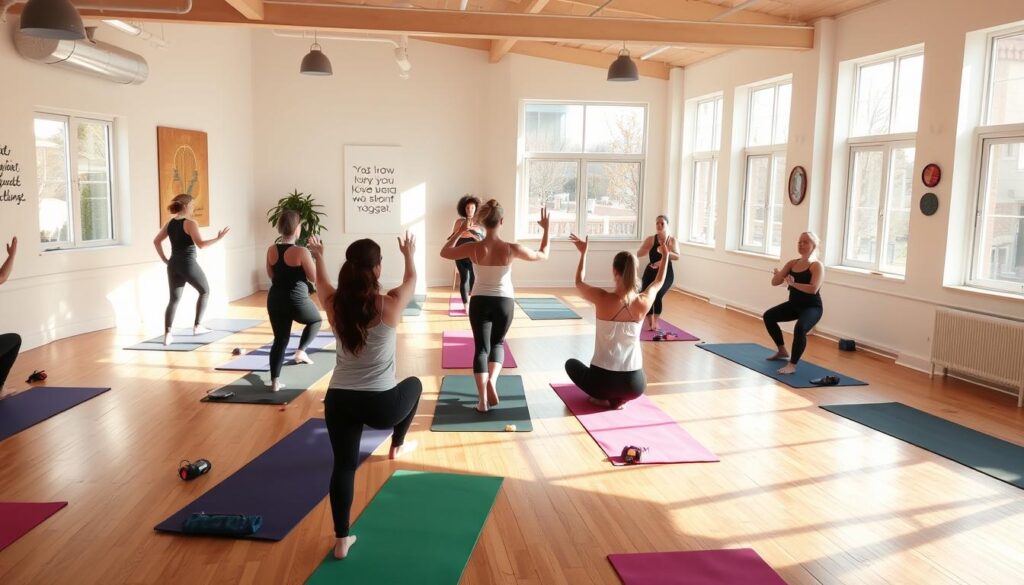
Recommended Apps and Websites
For beginners, several apps and websites can be incredibly helpful. Some popular options include:
- Down Dog: Offers guided practices and customizable sessions.
- YogaGlo: Provides a wide range of classes for all levels.
- Gaia: Features yoga, meditation, and wellness content.
The Importance of Community
Being part of a supportive yoga community can significantly enhance your practice. It provides motivation, inspiration, and a sense of belonging. Whether you join a local studio or connect with online groups, being around people who share your passion for yoga can be truly transformative.
| Resource | Description | Benefits |
|---|---|---|
| Yoga Studios | Physical locations offering classes | Personal interaction, immersive experience |
| Online Classes | Virtual classes accessible from home | Flexibility, convenience, variety |
| Yoga Apps/Websites | Digital platforms with guided practices | Customizable, accessible, diverse content |
As you explore these resources, remember that your yoga journey is unique. Find what works best for you and enjoy the process of growth and self-discovery.
Embracing Your Yoga Journey
As you begin your yoga journey, remember that the practice is a personal and transformative experience that extends beyond the mat. The yoga health benefits you’ve discovered throughout this article are just the starting point. By incorporating yoga into your daily routine, you’ll cultivate physical, mental, and emotional well-being.
Be patient with your progress, and don’t be afraid to explore different styles and techniques. Whether you’re practicing yoga at home or in a studio, the key is to maintain consistency and listen to your body’s needs. As you continue on your path, you’ll discover the profound impact of yoga on your overall health and happiness.
Embarking on a yoga journey is a celebration of self-care and self-discovery. By embracing the principles and practices of yoga, you’ll unlock a deeper sense of inner peace and harmony. Make yoga a part of your lifestyle, and you’ll reap the rewards of a healthier, happier you.
FAQ
What is the best type of yoga for beginners?
For beginners, Hatha, Vinyasa, and Restorative yoga are excellent options. Hatha yoga focuses on physical postures and breathing techniques, Vinyasa yoga emphasizes flowing movements, and Restorative yoga promotes relaxation and rejuvenation.
What are the benefits of practicing yoga?
Yoga offers numerous benefits, including improved flexibility, strength, and balance, as well as reduced stress and anxiety. Regular practice can also enhance overall physical and mental well-being, promoting a sense of calm and inner peace.
Do I need to be flexible to start practicing yoga?
No, you don’t need to be flexible to start practicing yoga. Yoga is for every body, regardless of flexibility or fitness level. With regular practice, you can improve your flexibility and range of motion.
What should I wear to a yoga class?
Wear comfortable, breathable clothing that allows for a full range of motion. Avoid loose or baggy clothing that may get in the way of your movements or cause distractions.
Can I practice yoga at home, or do I need to join a studio?
You can practice yoga at home, and there are many online resources and videos available to guide you. However, joining a yoga studio or class can provide a supportive community, expert instruction, and a more immersive experience.
How often should I practice yoga to see benefits?
Consistency is key. Aim to practice yoga at least 2-3 times per week, and ideally daily if possible. Even a short practice each day can be beneficial, and you can gradually increase your practice as you become more comfortable with the poses and techniques.
Are there any health benefits to practicing yoga regularly?
Yes, regular yoga practice has been shown to have numerous health benefits, including reduced blood pressure, improved sleep, and enhanced immune function. Yoga can also help manage chronic pain, improve mood, and reduce symptoms of anxiety and depression.
Can yoga help with stress and anxiety?
Yes, yoga is known to help reduce stress and anxiety by promoting relaxation, calming the mind, and regulating the body’s response to stress. Regular practice can lead to a greater sense of calm and well-being.
